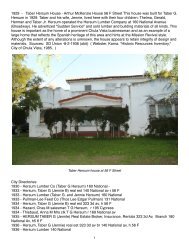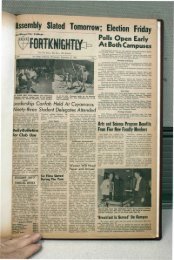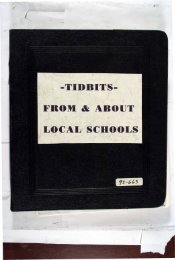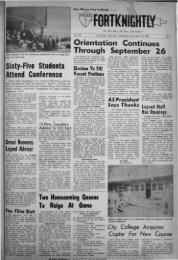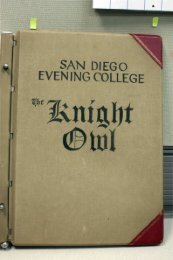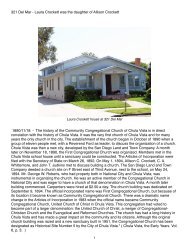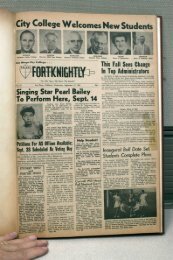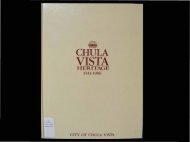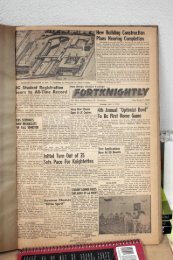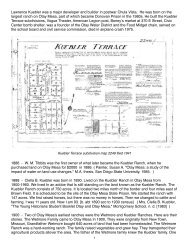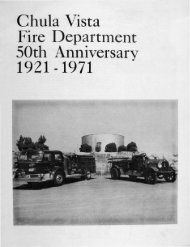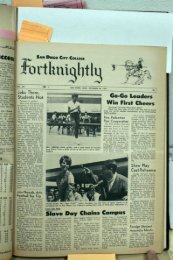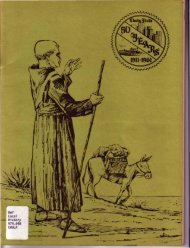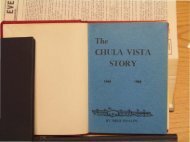doc241 - Schoenherr Home Page in Sunny Chula Vista
doc241 - Schoenherr Home Page in Sunny Chula Vista
doc241 - Schoenherr Home Page in Sunny Chula Vista
Create successful ePaper yourself
Turn your PDF publications into a flip-book with our unique Google optimized e-Paper software.
his old neighbors. From this time onward he was a resident and active worker for the<br />
new city.<br />
In 1852, he was elected and served as associate justice of the court of sessions.<br />
He also became secretary of the board of trade and held the office twelve years. April<br />
21, 1856, he was admitted to the practice of law. In 1858-9 he served as county treasurer,<br />
and aga<strong>in</strong> <strong>in</strong> 1861-2-3. In 1866-7 he was city trustee and <strong>in</strong> the latter year was <strong>in</strong>strumental<br />
<strong>in</strong> sell<strong>in</strong>g the city's lands to A. E. Horton. He had shown his faith <strong>in</strong> the new<br />
town by settl<strong>in</strong>g there upon his first arrival; and he now stood by Horton and did everyth<strong>in</strong>g<br />
<strong>in</strong> his power to aid <strong>in</strong> build<strong>in</strong>g up the new addition.<br />
From the time of his removal to Horton's Addition he began to prosper and became<br />
a vital element <strong>in</strong> the life of the new town. In 1870 he was a lead<strong>in</strong>g spirit <strong>in</strong> the<br />
organization of the first bank <strong>in</strong> San Diego, the Bank of San Diego, which later was<br />
merged <strong>in</strong> the Consolidated National Bank, <strong>in</strong> both of which, as well as <strong>in</strong> the San Diego<br />
Sav<strong>in</strong>gs Bank, he was cont<strong>in</strong>uously a director and officer. In 1871, he went to Wash<strong>in</strong>gton<br />
city to represent San Diego <strong>in</strong> the matter of its pueblo lands, and argued the case<br />
with skill and ability. In company with James M. Pierce he built the handsome and substantial<br />
Pierce-Morse block on the northwest corner of Sixth and F Streets, and, <strong>in</strong> company<br />
with Messrs. Whaley and Dalton, the Morse, Whaley & Dalton block. At one time<br />
he was quite wealthy, but the collapse of the great boom hit him very hard, and he never<br />
fully recovered.<br />
He was one of the prime movers <strong>in</strong> the organization of the San Diego & Gila Railroad<br />
and acted as a director and officer as long as the organization cont<strong>in</strong>ued. He was<br />
also prom<strong>in</strong>ently connected with all other railroad projects from that time until his death,<br />
and probably knew the story of San Diego's struggle<br />
<strong>Page</strong> 283<br />
[Ephraim W. Morse, the ideal citizen]<br />
<strong>Page</strong> 284<br />
for railroad facilities better than any other man. At the time the representatives of the<br />
Santa Fe came to San Diego, <strong>in</strong> October, 1879, he was secretary of the Citizens' Committee,<br />
charged with the duty of furnish<strong>in</strong>g the visitors with <strong>in</strong>formation. This duty he performed<br />
<strong>in</strong> a remarkably efficient manner, promptly produc<strong>in</strong>g everyth<strong>in</strong>g called for, and<br />
answer<strong>in</strong>g all questions clearly and accurately. His associates testify that his great<br />
knowledge and untir<strong>in</strong>g energy on this occasion were among the strongest elements<br />
contribut<strong>in</strong>g to the br<strong>in</strong>g<strong>in</strong>g of the railroad.<br />
Among other activities, he was a member of the real estate firm of Morse, Noell &<br />
Whaley from 1880 to 1886, and for about a year longer of the firm of Morse, Whaley &<br />
Dalton. He was also connected with the San Diego Flume Company and made a considerable<br />
<strong>in</strong>vestment <strong>in</strong> it. He was public adm<strong>in</strong>istrator <strong>in</strong> 1876-7. He had little taste for<br />
office, however, and only served when he felt it to be a duty. One of his greatest services<br />
was <strong>in</strong> connection with the park, which he was <strong>in</strong>strumental <strong>in</strong> hav<strong>in</strong>g set aside.<br />
With characteristic steadfastness, he was a friend of the park to the end and stood up<br />
for its preservation and improvement, even when others weakened. He was a truly public<br />
spirited citizen, to whom no worthy enterprise or charity appealed <strong>in</strong> va<strong>in</strong>. He was an



